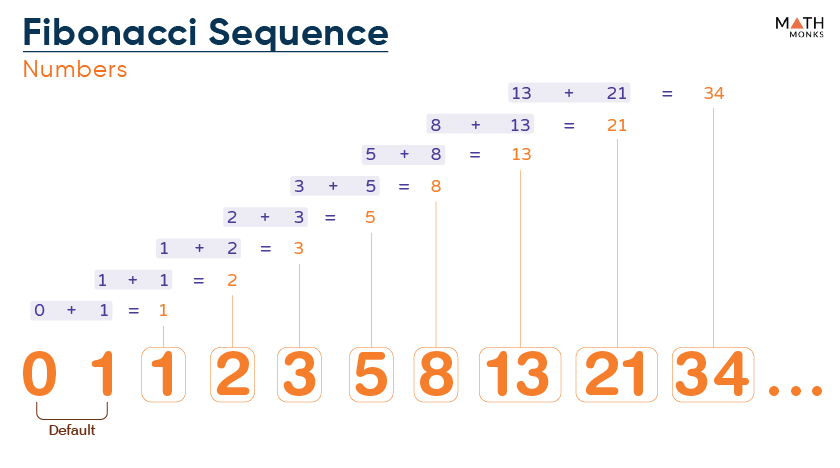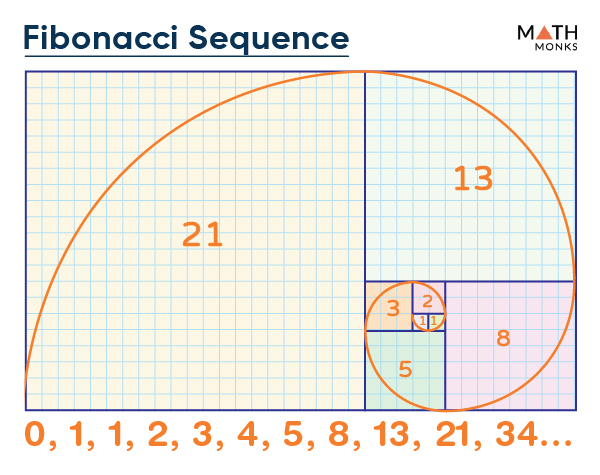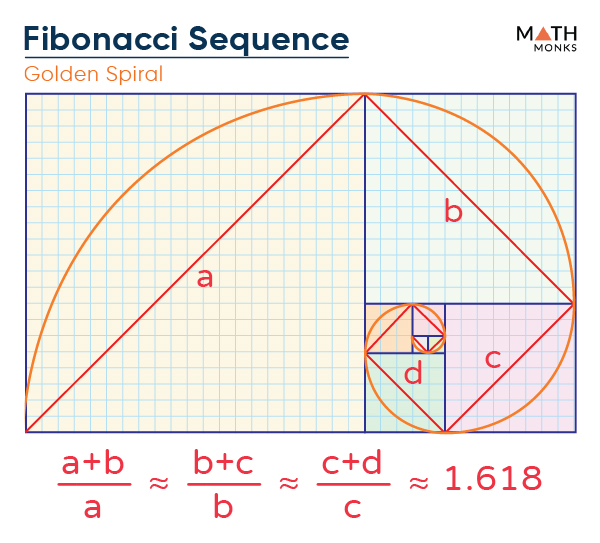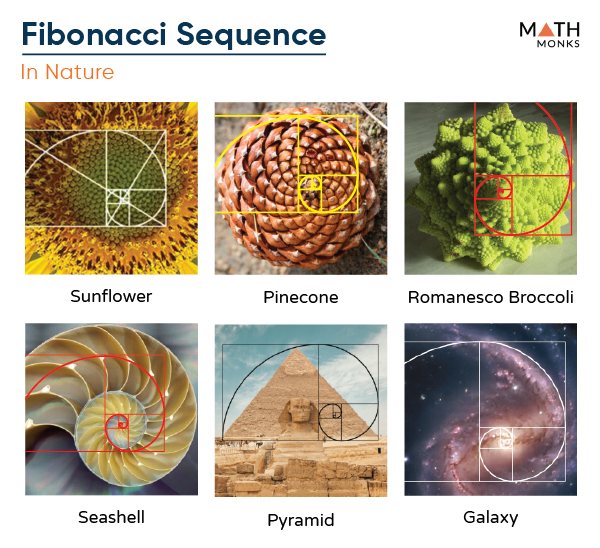
The Fibonacci Sequence is a number series in which each number is obtained by adding its two preceding numbers. It starts with 0 and is followed by 1. The numbers in this sequence, known as the Fibonacci numbers, are denoted by Fn.
The first few numbers of the Fibonacci Sequence are as follows.

The above sequence can be written as a ‘Rule’, which is expressed with the following equation.

Using this equation, we can conclude that the sequence continues to infinity.
The following table lists each term and term value in the Fibonacci Sequence till the 10 th .
| Term Position | Fn Term | Term Value / Fibonacci number |
|---|---|---|
| 1 st | F0 | 0 |
| 2 nd | F1 | 1 |
| 3 rd | F2 | 1 |
| 4 th | F3 | 2 |
| 5 th | F4 | 3 |
| 6 th | F5 | 5 |
| 7 th | F6 | 8 |
| 8 th | F7 | 13 |
| 9 th | F8 | 21 |
| 10 th | F9 | 34 |
The numbers in the sequence follow some interesting patterns:
Since the Fibonacci sequence is formed by adding the previous two Fibonacci numbers, it is recursive in nature.
To calculate the 50 th term, we need the sum of the 48 th and 49 th terms.
Geometrically, the sequence forms a spiral pattern. It starts with a small square, followed by a larger one adjacent to the first square. It is followed by the sum of the two previous squares, where each square fits into the next one, showing a spiral pattern expanding up to infinity.
The following graph represents it.

The limits of the squares of all the consecutive Fibonacci numbers create the Fibonacci Spiral.
The Fibonacci Sequence has some important properties, which we will discuss below.
Two successive Fibonacci numbers give the value $<\phi =\dfrac<1+\sqrt<5>>>$ or, 1.618…, which is known as the Golden Ratio, also known as phi (an irrational number).
For the given spiral, the Golden ratio follows the property:

It follows a constant angle close to the Golden Ratio and is commonly known as the Golden Spiral. In geometry, this ratio forms a Golden rectangle, a rectangle whose ratio of its length and breadth gives the Golden Ratio. It appears in many works of art and architecture.
Using the Golden Ratio, we can approximately calculate any Fibonacci numbers as
This is known as Binet’s Formula.
The sum of the Fibonacci Sequence is obtained by:
where Fn is the nth Fibonacci number, and the sequence starts from F0.
The sum of the first 12 terms = (12+2) th term – 2 nd term
= 14 th term – 2 nd term
We get another number sequence from the Fibonacci Sequence that follows the same rule mathematically.
Here, the number sequence starting from 2 is formed by adding two preceding numbers, known as Lucas numbers.
The sequence is as follows:
2, 1, 3, 4, 7, ….
| Number of terms (n) | Lucas number | $<\phi ^ |
|---|---|---|
| 0 | 2 | 1.0 |
| 1 | 1 | 1.6180… |
| 2 | 3 | 2.6180… |
| 3 | 4 | 4.2361… |
| 4 | 7 | 6.8541… |
| 5 | 11 | 11.0902… |
| 6 | 18 | 17.9443… |
Thus, the Lucas numbers are found to get closer to the powers of the Golden Ratio.
We can also derive the sequence in Pascal’s triangle from the Fibonacci Sequence. It is a number triangle that starts with 1 at the top, and each row has 1 at its two ends. Here, the middle numbers of each row are the sum of the two numbers above it.

We find the Fibonacci Sequence in various fields, from nature to the human body.
Find the sum of the first 15 Fibonacci numbers.
As we know,
The sum of the Fibonacci Sequence = $_F_ = F_ – F_>$
= $
Thus, the sum of the first 15 Fibonacci numbers = (15+2) th term – 2 nd term
= 17 th term – 1
= 987 – 1
= 986
Find the 5 th Fibonacci number.
As we know,
The n th Fibonacci number is F(xn ) = F(xn-1) + F(xn-2), for n>2
Then the 5 th Fibonacci number is F(x5 ) = F(x5-1) + F(x5-2), for n=5
= F(x4) + F(x3)
= 2 + 1
= 3
Find the next number when F14 = 377.
Here,
F15 = F14 x Golden ratio
= 377 x 1.618034 (up to 4 decimals)
= 609.9988 (up to 4 decimals), which is approximately 610
Hence, F15 = 610
Calculate the value of F-6.